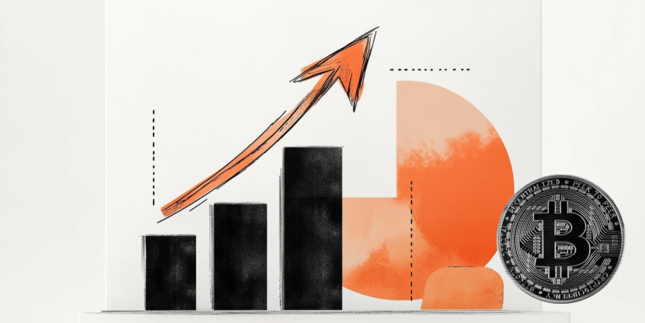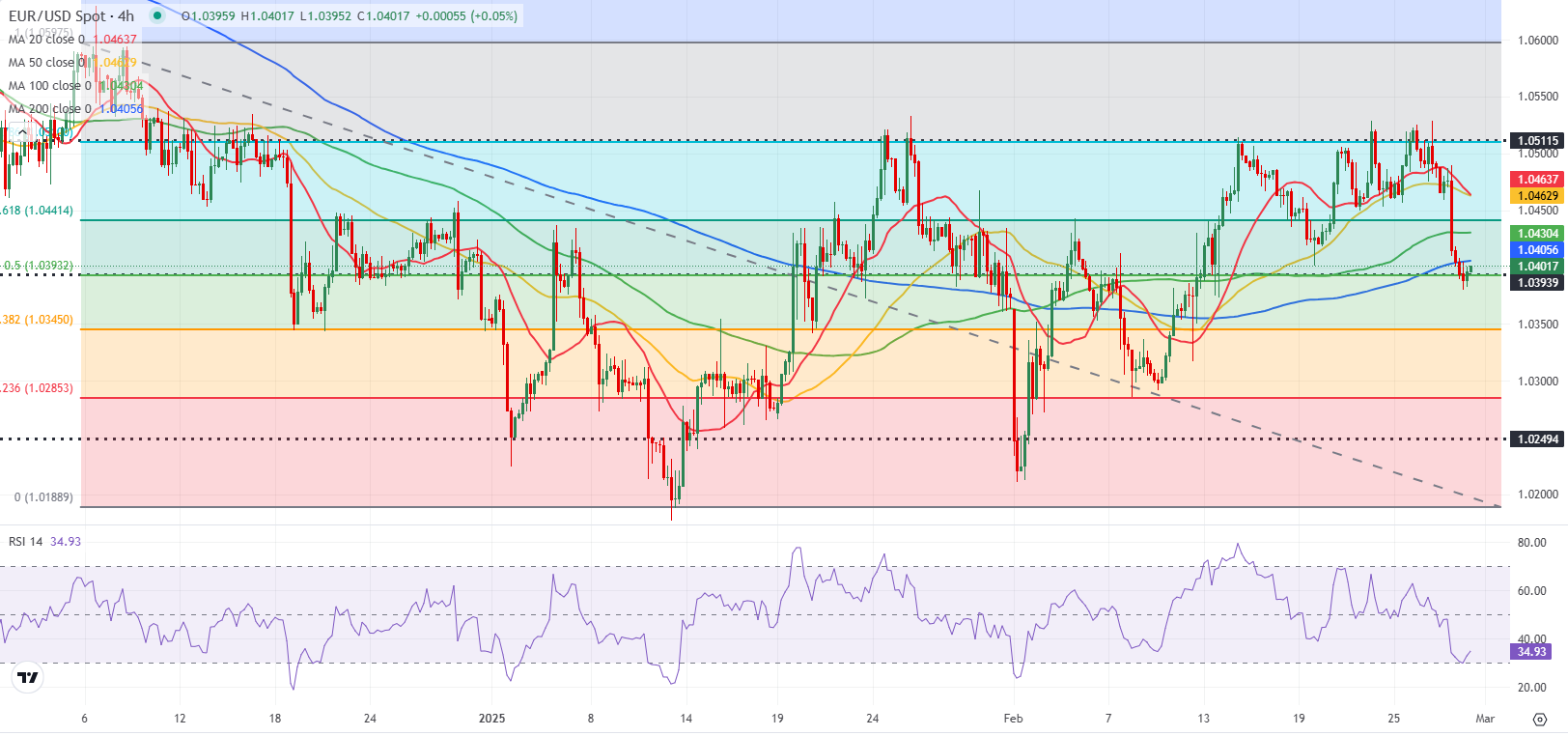- EUR/USD trades marginally lower on the day below 1.0400 early Friday.
- The technical outlook points to a buildup of bearish momentum.
- Markets await inflation data from Germany and the US.
EUR/USD struggles to stage a rebound and trades below 1.0400 in the European morning on Friday after posting large losses on Thursday. The pair's technical outlook highlights a bearish shift in the short-term bias as market focus shifts to key inflation data releases from Germany and the US.
Euro PRICE This week
The table below shows the percentage change of Euro (EUR) against listed major currencies this week. Euro was the weakest against the US Dollar.
| USD | EUR | GBP | JPY | CAD | AUD | NZD | CHF | |
|---|---|---|---|---|---|---|---|---|
| USD | 0.58% | 0.30% | 0.80% | 1.52% | 2.27% | 2.46% | 0.33% | |
| EUR | -0.58% | -0.37% | 0.05% | 0.75% | 1.67% | 1.68% | -0.42% | |
| GBP | -0.30% | 0.37% | 0.45% | 1.12% | 2.04% | 2.05% | -0.06% | |
| JPY | -0.80% | -0.05% | -0.45% | 0.72% | 1.55% | 1.73% | -0.38% | |
| CAD | -1.52% | -0.75% | -1.12% | -0.72% | 0.69% | 0.93% | -1.16% | |
| AUD | -2.27% | -1.67% | -2.04% | -1.55% | -0.69% | 0.00% | -2.06% | |
| NZD | -2.46% | -1.68% | -2.05% | -1.73% | -0.93% | -0.01% | -2.06% | |
| CHF | -0.33% | 0.42% | 0.06% | 0.38% | 1.16% | 2.06% | 2.06% |
The heat map shows percentage changes of major currencies against each other. The base currency is picked from the left column, while the quote currency is picked from the top row. For example, if you pick the Euro from the left column and move along the horizontal line to the US Dollar, the percentage change displayed in the box will represent EUR (base)/USD (quote).
The US Dollar (USD) gathered strength in the American session on Thursday and triggered a leg lower in EUR/USD as safe-haven flows dominated the action in financial markets.
After suggesting on Wednesday that the 25% tariff package on Mexican and Canadian imports would go into effect on April 2nd, US President Donald Trump clarified on Thursday that they will be imposed on March 4th as initially planned. He further noted that China will also be charged an extra 10% tariff on that date. In response, major equity indexes in the US declined sharply, allowing the USD to outperform its risk-sensitive rivals.
The Consumer Price Index (CPI) in Germany is forecast to rise 2.3% on a yearly basis in February, matching January's increase. A softer-than-forecast inflation reading could hurt the Euro with the immediate reaction.
Additionally, the US Bureau of Economic Analysis (BEA) will publish the Personal Consumption Expenditure (PCE) Price Index data for January. Although this report by itself is unlikely to alter the market pricing of the Federal Reserve's rate outlook in a significant way, a monthly core PCE Price Index increase of 0.4%, or higher, could further boost the USD and weigh on EUR/USD.
EUR/USD Technical Analysis
The Relative Strength Index (RSI) indicator on the 4-hour chart stays well below 40 after EUR/USD closed below the 20-day Simple Moving Average (SMA) for the first time in over two weeks on Thursday, reflecting a bearish shift in the short-term outlook.
On the downside, 1.0350 (Fibonacci 38.2% retracement of the latest downtrend) aligns as next support before 1.0300-1.0290 (round level, Fibonacci 23.6% retracement) and 1.0250 (static level). In case EUR/USD stabilizes above 1.0390-1.0400 (Fibonacci 50% retracement, 200-period SMA) and confirms this level as support, 1.0440 (Fibonacci 61.8% retracement) and 1.0500-1.0510 (Fibonacci 78.6% retracement, static level) could be seen as next resistance levels.
Inflation FAQs
Inflation measures the rise in the price of a representative basket of goods and services. Headline inflation is usually expressed as a percentage change on a month-on-month (MoM) and year-on-year (YoY) basis. Core inflation excludes more volatile elements such as food and fuel which can fluctuate because of geopolitical and seasonal factors. Core inflation is the figure economists focus on and is the level targeted by central banks, which are mandated to keep inflation at a manageable level, usually around 2%.
The Consumer Price Index (CPI) measures the change in prices of a basket of goods and services over a period of time. It is usually expressed as a percentage change on a month-on-month (MoM) and year-on-year (YoY) basis. Core CPI is the figure targeted by central banks as it excludes volatile food and fuel inputs. When Core CPI rises above 2% it usually results in higher interest rates and vice versa when it falls below 2%. Since higher interest rates are positive for a currency, higher inflation usually results in a stronger currency. The opposite is true when inflation falls.
Although it may seem counter-intuitive, high inflation in a country pushes up the value of its currency and vice versa for lower inflation. This is because the central bank will normally raise interest rates to combat the higher inflation, which attract more global capital inflows from investors looking for a lucrative place to park their money.
Formerly, Gold was the asset investors turned to in times of high inflation because it preserved its value, and whilst investors will often still buy Gold for its safe-haven properties in times of extreme market turmoil, this is not the case most of the time. This is because when inflation is high, central banks will put up interest rates to combat it. Higher interest rates are negative for Gold because they increase the opportunity-cost of holding Gold vis-a-vis an interest-bearing asset or placing the money in a cash deposit account. On the flipside, lower inflation tends to be positive for Gold as it brings interest rates down, making the bright metal a more viable investment alternative.
Information on these pages contains forward-looking statements that involve risks and uncertainties. Markets and instruments profiled on this page are for informational purposes only and should not in any way come across as a recommendation to buy or sell in these assets. You should do your own thorough research before making any investment decisions. FXStreet does not in any way guarantee that this information is free from mistakes, errors, or material misstatements. It also does not guarantee that this information is of a timely nature. Investing in Open Markets involves a great deal of risk, including the loss of all or a portion of your investment, as well as emotional distress. All risks, losses and costs associated with investing, including total loss of principal, are your responsibility. The views and opinions expressed in this article are those of the authors and do not necessarily reflect the official policy or position of FXStreet nor its advertisers. The author will not be held responsible for information that is found at the end of links posted on this page.
If not otherwise explicitly mentioned in the body of the article, at the time of writing, the author has no position in any stock mentioned in this article and no business relationship with any company mentioned. The author has not received compensation for writing this article, other than from FXStreet.
FXStreet and the author do not provide personalized recommendations. The author makes no representations as to the accuracy, completeness, or suitability of this information. FXStreet and the author will not be liable for any errors, omissions or any losses, injuries or damages arising from this information and its display or use. Errors and omissions excepted.
The author and FXStreet are not registered investment advisors and nothing in this article is intended to be investment advice.
Recommended Content
Editors’ Picks

AUD/USD oscillates in a range below 0.6300 amid mixed cues
AUD/USD struggles to build on the previous day's positive move and remains below the 0.6300 mark ahead of Trump's tariffs announcement later this Wednesday. In the meantime, the cautious market mood lends some support to the safe-haven USD and caps the upside for the pair.

USD/JPY remains below 150.00 as traders await Trump's tariffs
USD/JPY regains positive traction on Wednesday as receding bets that the BoJ would raise the policy rate at a faster pace undermine the JPY. Spot prices, however, remain confined in the weekly range as traders wait on the sidelines ahead of Trump's reciprocal tariffs announcement.

Gold price holds comfortably above $3,100 amid trade jitters
Gold price attracts some dip-buyers following the previous day's retracement slide from the record high amid persistent safe-haven demand, bolstered by worries about a tariff-driven global economic slowdown. Furthermore, Fed rate cut expectations and the lack of USD buying interest offer additional support to the XAU/USD.

US Government to conclude BTC, ETH, XRP, SOL, and ADA reserves audit next Saturday
Bitcoin price rose 3% on Tuesday, as MicroStrategy, Metaplanet and Tether all announced fresh BTC purchase. However, BTC price is likely to remain volatile ahead of the anticipated disclosure of U.S. government crypto holdings, which could fuel speculation in the coming days.

Is the US economy headed for a recession?
Leading economists say a recession is more likely than originally expected. With new tariffs set to be launched on April 2, investors and economists are growing more concerned about an economic slowdown or recession.

The Best brokers to trade EUR/USD
SPONSORED Discover the top brokers for trading EUR/USD in 2025. Our list features brokers with competitive spreads, fast execution, and powerful platforms. Whether you're a beginner or an expert, find the right partner to navigate the dynamic Forex market.
